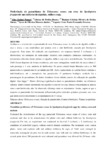Use este identificador para citar ou linkar para este item:
http://www.alice.cnptia.embrapa.br/alice/handle/doc/907942| Título: | Preferência de parasitismo de Telenomus remus em ovos de Spodoptera frugiperda nas culturas de algodão, milho e soja. |
| Autoria: | POMARI, A. F.  BUENO, A. de F.   BUENO, R. C. O. de F.   MENEZES JUNIOR, A. de O.   FONSECA, A. C. P. F.   |
| Afiliação: | ALINE FARHAT POMARI, USP; ADENEY DE FREITAS BUENO, CNPSO; REGIANE CRISTINA OLIVEIRA DE FREITAS BUENO, UEL; AYRES DE OLIVEIRA MENEZES JUNIOR, UFSC; AUGUSTO CESAR PRADO FERNANDES FONSECA, UFSC. |
| Ano de publicação: | 2011 |
| Referência: | In: CONGRESSO BRASILEIRO DE DEFENSIVOS AGRÍCOLAS NATURAIS, 5., 2011, Jaguariúna. [Anais...]. Jaguariúna: Embrapa Meio Ambiente, 2011. Pôster 64. |
| Páginas: | 4 p. |
| Conteúdo: | Avaliou-se a atratividade do parasitoide de ovos Telenomus remus às culturas de algodão, milho e soja e ainda, a sua atratividade por plantas com e sem herbivoria causada por Spodoptera frugiperda. Para tanto, foi realizado um experimento, em esquema fatorial 3 (culturas) x 2 (herbivoria), em condições de semi-campo (telados), sem condições climáticas controladas. Os tratamentos utilizados foram: plantas de algodão, milho e soja com e sem herbivoria. Em telados de 24m², foram dispostos de forma concêntrica, seis vasos retangulares sendo dois de cada cultura (1 com presença e 1 com ausência de herbivoria). No ponto central foram liberados cerca de 300 parasitoides e o parasitismo foi permitido por 24h. Após o parasitismo as cartelas foram retiradas e individualizadas até a emergência dos parasitoides. O parâmetro biológico avaliado foi a porcentagem de parasitismo. Os dados climáticos foram obtidos através da utilização do aparelho digital ?data logger?. Houve diferença significativa entre os parasitismos obtidos nas diferentes culturas, sendo o maior encontrado em algodão e o menor em soja. Quando relacionadas às plantas com e sem herbivoria, não foi observada diferença entre os tratamentos. Assim, sugere-se que a resposta do parasitoide foi diretamente influenciada pelos estímulos químicos presentes nos ovos que alteraram favoravelmente o comportamento de T. remus. Parasitism preference of Telenomus remus in Spodoptera frugiperda eggs by cotton, corn and soybean. Evaluated the attractiveness of the egg parasitoid Telenomus remus crops of cotton, corn and soybeans and also to its attractiveness for plants with and without herbivory by Spodoptera frugiperda. For this, an experiment was conducted in factorial 3 (culture) x 2 (herbivory), in conditions of semi-field (cages), without control climatic conditions. The treatments were: cotton plants, maize and soybean with and without herbivory. In cages of 24m², were arranged in concentric rectangular six pots two in each culture (one with and one without herbivory). At the central point about 300 parasitoids were released and parasitism was allowed for 24 hours. After riding the cards were removed and isolated until the parasitoids emergence. The biological parameter measured was the parasitism percentage. Climatic data were obtained through the use of a digital ?data logger?. The results showed a significant difference between parasitism obtained in different cultures, being the largest found in cotton and the lowest in soybean. In connection with the plants with and without herbivory, there was no diference between treatments.Therefore, it is suggested that the response of the parasitoid was directly influenced by chemical stimulus present in the eggs that favorably alter the behavior of T. remus. |
| Thesagro: | Controle biológico Praga de planta Algodão Milho Soja |
| NAL Thesaurus: | Plant pests Biological control Soybeans Cotton Corn |
| Tipo do material: | Artigo em anais e proceedings |
| Acesso: | openAccess |
| Aparece nas coleções: | Artigo em anais de congresso (CNPSO)  |
Arquivos associados a este item:
| Arquivo | Descrição | Tamanho | Formato | |
|---|---|---|---|---|
| adeney.64.pdf | 35,6 kB | Adobe PDF |  Visualizar/Abrir |









